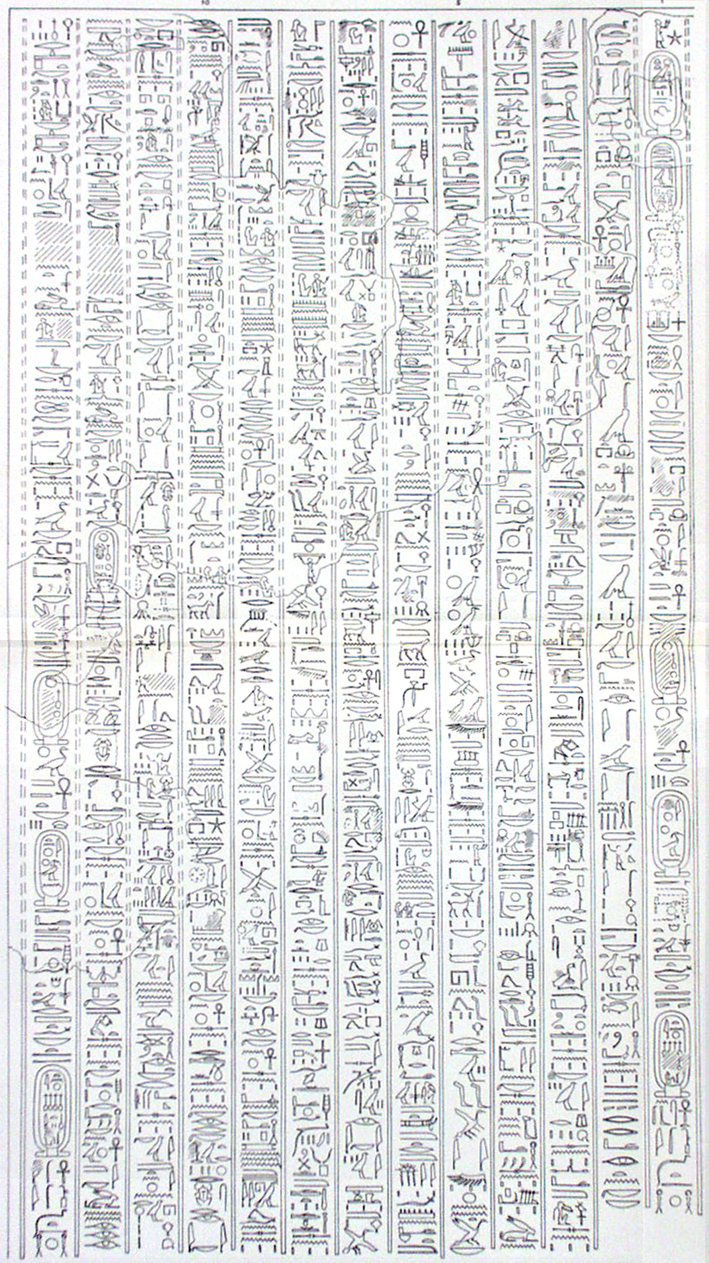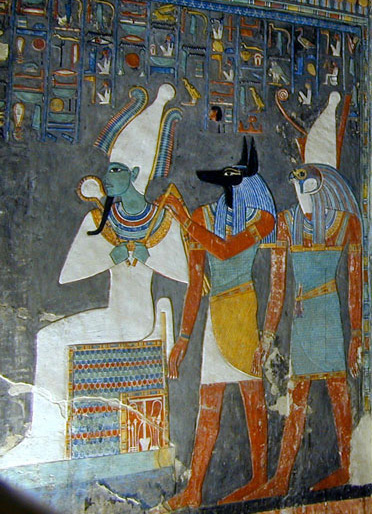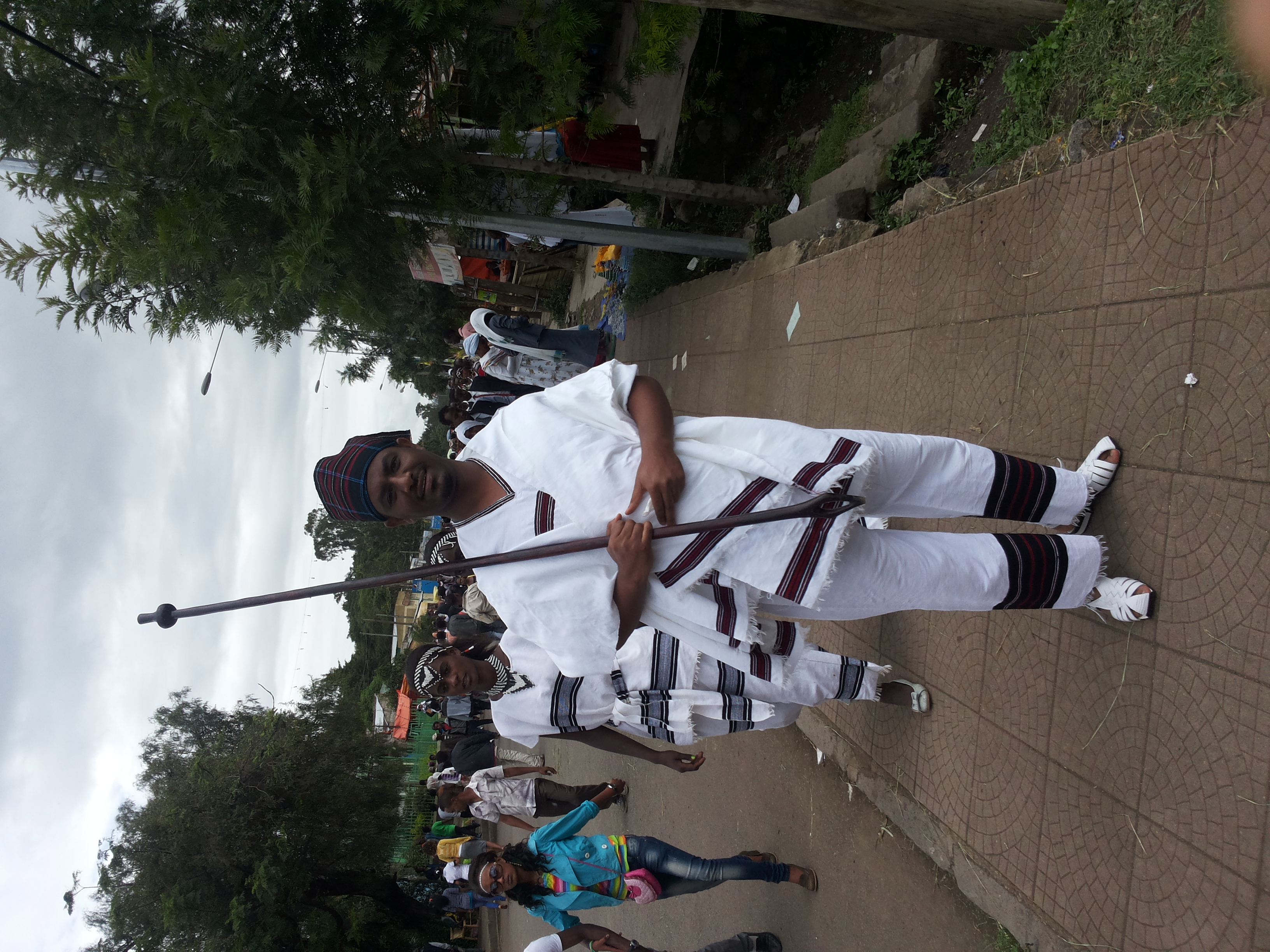|
Sai (deity)
Shai (also spelt Sai, occasionally Shay, and in Greek, Psais) was the deification of the concept of fate in Egyptian mythology. As a concept, with no particular reason for associating one gender over another, Shai was sometimes considered female, rather than the more usual understanding of being male, in which circumstance Shai was referred to as Shait (simply the feminine form of the name). His name reflects his function, as it means ''(that which is) ordained''. The Egyptians believed that Shai determined the length of each person’s life and was born with each person at their birth and remained at their side until they faced their final judgement before Osiris in the underworld Duat. In consequence, he was sometimes identified as the husband of Meskhenet, goddess of birth, or, in later years, of Renenutet, who assigned the Ren, and had become considered goddess of fortune. Because of the power associated in the concept, Akhenaten, in introducing monotheism, said that Shai wa ... [...More Info...] [...Related Items...] OR: [Wikipedia] [Google] [Baidu] |
Meskhenet
In ancient Egyptian mythology, Meskhenet, (also spelt Mesenet, Meskhent, and Meshkent) was the goddess of childbirth, and the creator of each child's Ka, a part of their soul, which she breathed into them at the moment of birth. She was worshipped from the earliest of times by Egyptians. In mythology In ancient Egypt, women delivered babies while squatting on a pair of bricks, known as "birth bricks", and Meskhenet was the goddess associated with this form of delivery. Consequently, in art, she was sometimes depicted as a brick with a woman's head, wearing a cow's uterus upon it. At other times she was depicted as a woman with a symbolic cow's uterus on her headdress. Since she was responsible for creating the Ka, she was associated with fate. Thus later she was sometimes said to be paired with Shai, who became a god of destiny after the deity evolved out of an abstract concept. Meskhenet features prominently in the last of the folktales in the Westcar Papyrus. The story tells ... [...More Info...] [...Related Items...] OR: [Wikipedia] [Google] [Baidu] |
Aten
Aten, also Aton, Atonu, or Itn (, reconstructed ) was the focus of Atenism, the religious system formally established in ancient Egypt by the late Eighteenth Dynasty pharaoh Akhenaten. Exact dating for the Eighteenth Dynasty is contested, though a general date range places the dynasty in the years 1550 to 1292 BCE. The worship of Aten and the coinciding rule of Akhenaten are major identifying characteristics of a period within the Eighteenth Dynasty referred to as the Amarna Period (1336 BCE). Atenism and the worship of the Aten as the sole god of ancient Egypt state worship did not persist beyond Akhenaten's death. Not long after his death, one of Akhenaten's Eighteenth Dynasty successors, Tutankhamun, reopened the state temples to other Egyptian gods and re-positioned Amun as the pre-eminent solar deity. Aten is depicted as a solar disc emitting rays terminating in human hands. Etymology The word ''Aten'' appears in the Old Kingdom as a noun meaning "disc" w ... [...More Info...] [...Related Items...] OR: [Wikipedia] [Google] [Baidu] |
Time And Fate Gods
Time is the continuous progression of existence that occurs in an apparently irreversible succession from the past, through the present, and into the future. It is a component quantity of various measurements used to sequence events, to compare the duration of events (or the intervals between them), and to quantify rates of change of quantities in material reality or in the conscious experience. Time is often referred to as a fourth dimension, along with three spatial dimensions. Time is one of the seven fundamental physical quantities in both the International System of Units (SI) and International System of Quantities. The SI base unit of time is the second, which is defined by measuring the electronic transition frequency of caesium atoms. General relativity is the primary framework for understanding how spacetime works. Through advances in both theoretical and experimental investigations of spacetime, it has been shown that time can be distorted and dilated, particula ... [...More Info...] [...Related Items...] OR: [Wikipedia] [Google] [Baidu] |
Egyptian Gods
Ancient Egyptian deities are the gods and goddesses worshipped in ancient Egypt. The beliefs and rituals surrounding these gods formed the core of ancient Egyptian religion, which emerged sometime in prehistory. Deities represented natural forces and phenomena, and the Egyptians supported and appeased them through offerings and rituals so that these forces would continue to function according to '' maat'', or divine order. After the founding of the Egyptian state around 3100 BC, the authority to perform these tasks was controlled by the pharaoh, who claimed to be the gods' representative and managed the temples where the rituals were carried out. The gods' complex characteristics were expressed in myths and in intricate relationships between deities: family ties, loose groups and hierarchies, and combinations of separate gods into one. Deities' diverse appearances in art—as animals, humans, objects, and combinations of different forms—also alluded, through symbolism ... [...More Info...] [...Related Items...] OR: [Wikipedia] [Google] [Baidu] |
Egyptian Language
The Egyptian language, or Ancient Egyptian (; ), is an extinct branch of the Afro-Asiatic languages that was spoken in ancient Egypt. It is known today from a large corpus of surviving texts, which were made accessible to the modern world following the decipherment of the ancient Egyptian scripts in the early 19th century. Egyptian is one of the earliest known written languages, first recorded in the hieroglyphic script in the late 4th millennium BC. It is also the longest-attested human language, with a written record spanning over 4,000 years. Its classical form, known as " Middle Egyptian," served as the vernacular of the Middle Kingdom of Egypt and remained the literary language of Egypt until the Roman period. By the time of classical antiquity, the spoken language had evolved into Demotic, and by the Roman era, diversified into various Coptic dialects. These were eventually supplanted by Arabic after the Muslim conquest of Egypt, although Bohairic Coptic ... [...More Info...] [...Related Items...] OR: [Wikipedia] [Google] [Baidu] |
Serpent (symbolism)
The serpent, or snake, is one of the oldest and most widespread mythological symbols. The word is derived from Latin ''serpens'', a crawling animal or snake. Snakes have been associated with some of the oldest rituals known to humankindRobbins, Lawrence H., Alec C. Campbell, George A. Brook, Michael L. Murphy (June 2007). "World's Oldest Ritual Site? The 'Python Cave' at Tsodilo Hills World Heritage Site, Botswana". Nyame Akuma. ''Bulletin of the Society of Africanist Archaeologists'' (67). Retrieved 1 (2010). and represent dual expression of good and evil. The historian of religions Mircea Eliade observed in ''The Myth of the Eternal Return,'' "the serpent symbolizes chaos, the formless and nonmanifested." In ''The Symbolism of the Cross'', Traditionalist René Guénon contended that "the serpent will depict the series of the cycles of universal manifestation," "the indefinitude of universal Existence," and "the being's attachment to the indefinite series of cycles of manifestati ... [...More Info...] [...Related Items...] OR: [Wikipedia] [Google] [Baidu] |
Greek Mythology
Greek mythology is the body of myths originally told by the Ancient Greece, ancient Greeks, and a genre of ancient Greek folklore, today absorbed alongside Roman mythology into the broader designation of classical mythology. These stories concern the ancient Greek religion's view of the Cosmogony, origin and Cosmology#Metaphysical cosmology, nature of the world; the lives and activities of List of Greek deities, deities, Greek hero cult, heroes, and List of Greek mythological creatures, mythological creatures; and the origins and significance of the ancient Greeks' cult (religious practice), cult and ritual practices. Modern scholars study the myths to shed light on the religious and political institutions of ancient Greece, and to better understand the nature of mythmaking itself. The Greek myths were initially propagated in an oral tradition, oral-poetic tradition most likely by Minoan civilization, Minoan and Mycenaean Greece, Mycenaean singers starting in the 18th century&n ... [...More Info...] [...Related Items...] OR: [Wikipedia] [Google] [Baidu] |
Ptolemaic Egypt
Ptolemaic is the adjective formed from the name Ptolemy, and may refer to: Pertaining to the Ptolemaic dynasty * Ptolemaic dynasty, the Macedonian Greek dynasty that ruled Egypt founded in 305 BC by Ptolemy I Soter *Ptolemaic Kingdom Pertaining to a certain ancient writer *Relating to Ptolemy Claudius Ptolemy (; , ; ; – 160s/170s AD) was a Greco-Roman mathematician, astronomer, astrologer, geographer, and music theorist who wrote about a dozen scientific treatises, three of which were important to later Byzantine science, Byzant ..., 2nd-century AD geographer and astronomer/astrologer * Ptolemaic system, a geocentric model of the universe developed in detail by the astronomer Claudius Ptolemaeus See also * Ptolemy (name) {{disambig ... [...More Info...] [...Related Items...] OR: [Wikipedia] [Google] [Baidu] |
Ramses II
Ramesses II (sometimes written Ramses or Rameses) (; , , ; ), commonly known as Ramesses the Great, was an Pharaoh, Egyptian pharaoh. He was the third ruler of the Nineteenth Dynasty of Egypt, Nineteenth Dynasty. Along with Thutmose III of the Eighteenth Dynasty of Egypt, Eighteenth Dynasty, he is often regarded as the greatest, most celebrated, and most powerful pharaoh of the New Kingdom of Egypt, New Kingdom, which itself was the most powerful period of ancient Egypt. He is also widely considered one of ancient Egypt's most successful warrior pharaohs, conducting no fewer than 15 military campaigns, all resulting in victories, excluding the Battle of Kadesh, generally considered a stalemate. In Ancient Greek literature, ancient Greek sources, he is called Ozymandias, derived from the first part of his Egyptian-language regnal name: . Ramesses was also referred to as the "Great Ancestor" by successor pharaohs and the Egyptian people. For the early part of his reign, he focu ... [...More Info...] [...Related Items...] OR: [Wikipedia] [Google] [Baidu] |
Monotheism
Monotheism is the belief that one God is the only, or at least the dominant deity.F. L. Cross, Cross, F.L.; Livingstone, E.A., eds. (1974). "Monotheism". The Oxford Dictionary of the Christian Church (2 ed.). Oxford: Oxford University Press. A distinction may be made between exclusive monotheism, in which the one God is a singular existence, and both inclusive and pluriform monotheism, in which multiple gods or godly forms are recognized, but each are postulated as extensions of the same God. Monotheism is distinguished from henotheism, a religious system in which the believer worships one god without denying that others may worship different gods with equal validity, and monolatry, monolatrism, the recognition of the existence of many gods but with the consistent worship of only one deity. The term ''monolatry'' was perhaps first used by Julius Wellhausen. Monotheism characterizes the traditions of Abrahamic religions, Abrahamic religions such as Judaism, Samaritanism, Christi ... [...More Info...] [...Related Items...] OR: [Wikipedia] [Google] [Baidu] |
Renenutet
Renenūtet (also transliterated Ernūtet, Renen-wetet, Renenet) was a goddess of grain, grapes, nourishment and the harvest in the ancient Egyptian religion. The importance of the harvest caused people to make many offerings to Renenutet during harvest time. Initially, her cult was centered in Terenuthis. Renenutet was depicted as a cobra or as a woman with the head of a cobra. The verbs "to fondle, to nurse, or rear" help explain the name Renenutet. This goddess was a "nurse" who took care of the pharaoh from birth to death. She was also called "the mistress of provisions", "Renenutet mistress of the offerings", "Renenutet mistress of the food", and "Renenutet the venerable of the double granary", and "who maintains everybody". She was the female counterpart of Shai, "destiny", who represented the positive destiny of the child. Renenutet was called Thermouthis or Hermouthis in Greek. She embodied the fertility of the fields (both the vegetation and the soil itself) and was t ... [...More Info...] [...Related Items...] OR: [Wikipedia] [Google] [Baidu] |
Akhenaten
Akhenaten (pronounced ), also spelled Akhenaton or Echnaton ( ''ʾŪḫə-nə-yātəy'', , meaning 'Effective for the Aten'), was an ancient Egyptian pharaoh reigning or 1351–1334 BC, the tenth ruler of the Eighteenth Dynasty of Egypt, Eighteenth Dynasty. Before the fifth year of his reign, he was known as Amenhotep IV (, meaning "Amun is satisfied", Hellenized as ''Amenophis IV''). As a pharaoh, Akhenaten is noted for abandoning traditional ancient Egyptian religion of polytheism and introducing Atenism, or worship centered around Aten. The views of Egyptologists differ as to whether the religious policy was absolutely monotheism, monotheistic, or whether it was monolatristic, religious syncretism, syncretistic, or henotheistic. This culture shift away from traditional religion was reversed after his death. Akhenaten's monuments were dismantled and hidden, his statues were destroyed, and his name Damnatio memoriae, excluded from regnal list, lists of rulers compiled by lat ... [...More Info...] [...Related Items...] OR: [Wikipedia] [Google] [Baidu] |







